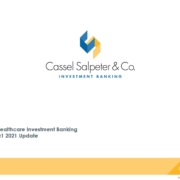As part of my series about “developments in the travel industry over the next five years”, I had the pleasure of interviewing Joseph “Joey” Smith.
Joseph Smith, director of aviation services at investment banking firm Cassel Salpeter & Co., has more than 25 years of experience in the capital markets and securities industry. At Cassel Salpeter, Smith leads the aviation team, providing the firm’s clients with his expertise in mergers and acquisitions, capital raising, and advisory services to middle market private and public companies. He has structured, negotiated, and executed on numerous aviation industry transactions with institutional private equity and strategic investors, and has worked extensively with business owners, management teams, and boards of directors and their professional advisors, locally and nationwide. Since 2018, Mr. Smith has led the publication of the firm’s quarterly Aviation Industry Deal Report offering insights on industry trends while charting deal flow. Before joining Cassel Salpeter in Miami, he served as a senior vice president of Catalyst Financial and as principal and head of investment banking for Capital City Partners. He began his middle market investment banking career at First Equity Corporation of Florida, where he was a principal and managing director after initially being trained by Merrill Lynch and Shearson Lehman Brothers. He received a bachelor’s degree in history from Hobart and William Smith Colleges in Geneva, N.Y.
Thank you so much for joining us in this interview series! Before we dive in, our readers would love to get to know you a bit better. Can you tell us a story about what brought you to this specific career path?
My investment banking path was unexpected as I was a history major from a small liberal arts college and never aspired for a career in finance or Wall Street, but I loved the stock market, and the historical aspect of corporations. Their operations, growth, and finance were fascinating to me. When Merrill Lynch surprisingly hired me, I became very adept at bringing in clients and assets, achieved success, and became enamored with the industry and was all in thereafter.
Can you share the most interesting story that happened to you since you started your career?
I don’t have a specific story that stands out as particularly interesting during my career, but rather have a period of time. That was when I was a broker/banker during the internet/technology dot-com boom, bubble, and ultimate bust times of the late 1990s and early 2000s. That was probably the most interesting chapter in my career. It was literally the Wild West of investing, with valuations being at astronomical levels for private placements, IPOs, buyouts, leading to huge failures and losses. That, combined with the excitement of technology truly advancing with the internet and new business models, while we were all trying to understand this new landscape and ecosystem and trying to pick the winners from the losers, made for fascinating times to be in the business.
Can you share a story about the funniest mistake you made when you were first starting? Can you tell us what lesson you learned from that?
Early in my career, I was tasked to make sure a prospectus was printed for an IPO (before EDGAR online, etc.) so I was camped out late night/early morning in the office of the printing company (standard operating practice). Unfortunately, I fell asleep and my printing cohorts decided to prank me, by locking me in the small conference room I was working from. When I awoke, I could not get out of the office, so I freaked out thinking the prospectus would be late to the SEC and my boss and client would fire me (no cell phones back then). I almost broke down the door before they let me out, and they took pictures of me, a disheveled mess running out with the huge prospectus box in tow. Very embarrassing, too, when they sent the blown-up picture to my boss to memorialize the prank, and thereafter hung it in the trading room for many years.
The lesson learned was that in business, do not ever let your guard down, and “coffee-up” for all-nighters. And generally, to always have a plan B for all unforeseen events, and backup, just in case “what if” happens. Be proactive and find a colleague to buddy up with to have your back and vice-versa!
Which tips would you recommend to your colleagues in your industry to help them to thrive and not “burn out”? Can you share a story about that?
As difficult as it is in the moment, be thinking long-term, protect your brand (image: how you are seen, perceived in the marketplace — internally and externally). Think of your career as a marathon with different milestones, constantly planting seeds and nurturing your story. Be willing to pivot and to forsake short-term gratification for the long haul. Be willing to be happy and to take risks, too. Try not to let yourself slide into a place where you are looking back with regrets because of inaction for the comforts of now.
For me, the entrepreneurial path was what I needed to explore when I was burning out, so I started my own advisory business, not necessarily to slow down, as I worked harder and longer hours than ever, but to control my own destiny and to have more flexibility for time with family.
None of us are able to achieve success without some help along the way. Is there a particular person who you are grateful towards who helped get you to where you are? Can you share a story?
My father, who taught me many lessons, always stressed that there is no substitute for hard work, to be a great listener, to always seek to do good (charity), and as for your adversaries, “to kill them with kindness.” He taught me that success is not defined by money, but by doing the right thing and being a well-respected and solid person to all who cross your path! His wisdom certainly defined my ultimate views on happiness, health, and success. I am trying to always pass it forward to my three adult children.
Can you share with our readers how have you used your success to bring goodness to the world?
I have always believed in giving back, paying it forward (preferably anonymously) because it truly makes me feel good to give. Whatever success I have is because of so many others (known and unknown), and I am thankful for whatever I have, and feel obligated to do my best to give back. I believe that writing checks to charities/organizations that interest you are not enough (though necessary) as I like to try to get involved in the organizations and leverage whatever I can bring to the table. Most importantly to me, is to find the time in our daily lives to do the little acts of kindness and to speak with or try to help/uplift a friend/acquaintance and strangers (too many of us run around with a phone on our ear, in our own little world ignoring others).
Thank you for that. Let’s jump to the core of our discussion. Can you share with our readers about the innovations that you are bringing to the Aviation and Air Travel industries?
As an investment banker, I cannot say that I am personally bringing innovation to the industry, but I would hope that some of our early-stage capital raising efforts may bring some interesting, cutting-edge, technology, and originality to the aerospace ecosystem.
Which “pain point” are industry leaders trying to address by introducing these innovations?
For travel industry leaders, efficiency and environmental responsibility are the pain points being addressed. Efficiency, as to travel time and experience, supply chain productivity, reducing expenses for all participants, while trying to reduce the carbon footprint and utilizing new technologies for the benefit of the entire ecosystem.
How do you envision that this might disrupt the status quo?
The major players in aerospace and aviation (Boeing, Airbus, GE, defense contractors) are certainly participating in innovation with disruptive next gen technology/systems, but the entrepreneurial start-up world is where things get interesting when thinking about the longer-term future of travel, here on earth and beyond.
Are there exciting new technologies that are coming out in the next few years that will improve the air travel experience? We’d love to learn about what you have heard.
There will be lots of new and exciting technologies to enhance the passenger experience from robots in the terminals, to quieter and faster planes, to drones assisting with baggage and security, but the truly disruptive advancements are currently being funded and will reveal their unique, value-add services during this coming decade. A few examples would be:
Eviation has leapfrogged the competition as the first zero-emission, all-electric airplane. Designed to take nine passengers up to 650 miles at a cruise speed of 240 knots on a single battery charge.
Boom Supersonic — founded in 2014 and having raised hundreds of millions is developing a delta-wing supersonic passenger aircraft. Its upcoming Overture jet will travel at Mach 2.2, making it the world’s fastest airliner. It will carry up to 45 passengers, aiming to start transporting passengers by 2023.
All-electric jets with VTOL (Vertical Take-Off and Landing) short range taxi start-ups: Lilium & Volocopter — Germany; Joby Aviation and Opener — USA, among others.
As you know, the pandemic changed the world as we know it. For the benefit of our readers, can you help spell out a few examples of how the pandemic has specifically impacted air travel?
The pandemic has crushed the commercial aviation industry unlike any other event. To encourage commercial travel, the industry has put in place some of the most aggressive cleaning/filtration systems in the world onto their aircraft, and have embraced as much touchless/remote activities as is feasible. The issue will always remain the “in air” safety, but also getting to and from the airport and the waiting in terminals for flights, from a social distancing perspective. The airlines have been quick to accommodate but until the vaccine is widespread, many will continue to err on the side of caution and not fly unless necessary.
Can you share five examples of how the air travel experience might change over the next few years to address the new realities brought by the pandemic? If you can, please give an example for each.
Airline/Airport Remote/Touchless enhancements — AI and biometrics to enhance airline checklists, check-in, baggage, security, and boarding (collaborating with FAA, TSA, airports and airlines)
Airline Leniency with Passengers — change fees, rewards programs, and pricing flexibility
Aircraft Manufacturer/OEM safety enhancements — Plane ventilation systems and various safety equipment installed permanently or during pandemic to best deal with virus microns.
Passengers destinations/preferences — will likely be more domestic oriented and shorter distances (to avoid layovers/cancellations)
Passenger Preparation — more thought regarding meals before flight, staying in seat more during flight, transportation to and from airport/hotels, being more selective vs. Uber/Lyft
You are a person of great influence. If you could start a movement that would bring the most amount of good to the most amount of people, what would that be?
I would love to find a way for the for-profit and nonprofit world to engage in a global transportation/humanitarian project to promote food and health care equity to the over a billion people globally living below the poverty line. If I am dreaming big without budgets or borders, this initiative would utilize all transportation modes: air, land, and sea with the best-in-class technology to promote the mandate. It would be a supply chain project to include the last mile of goods (to reduce corruption) for food and medical supplies, while also transporting those in need to the hospitals, schools, training facilities in the developed world. The human interaction and cultural exchange component would lift us all, with ongoing engagement programs to keep the connectivity through many educational/out-reach venues. The current system of providing the needy with food and health care services is not enough, it must be more thoughtful, organized, bilateral, and sustainable to train the next generation of providers from within these communities of need. Hey, I am thinking big and outside the proverbial box!
How can our readers further follow your work?






